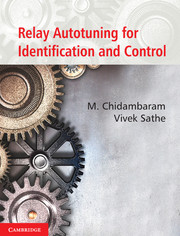Book contents
- Frontmatter
- Contents
- List of Figures
- List of Tables
- Acknowledgements
- Preface
- 1 Introduction
- 2 Improved Autotune Identification Methods
- 3 Cascade Controllers Tuning by Relay Autotune Method
- 4 Simultaneous Relay Autotuning of Cascade Controllers
- 5 A Simple Method of Tuning Cascade Controllers
- 6 Improved Saturation Relay Test for Systems with Large Dead Time
- 7 Identification of FOPTD Model using Single Symmetrical Relay Test
- 8 Autotuning of PID Controllers for Unstable FOPTD Systems
- 9 Autotuning of PID Controllers for Critically Damped SOPTD Systems
- 10 Estimation of SOPTD Transfer Function Model
- 11 Estimation of Five Parameters of Unstable SOPTD Model with a Zero
- 12 Identification of FOPTD Multivariable Systems
- 13 Identification of SOPTD Multivariable Systems
- 14 Tuning of Multivariable Controllers for Non-Minimum Phase Systems
- 15 Tuning of Multivariable Controllers by Genetic Algorithms
- 16 Summary and Conclusions
- Appendix A
- Appendix B
- Appendix C
- Nomenclature
- Problems
- Suggestive Reading
- References
- Index
2 - Improved Autotune Identification Methods
Published online by Cambridge University Press: 05 June 2014
- Frontmatter
- Contents
- List of Figures
- List of Tables
- Acknowledgements
- Preface
- 1 Introduction
- 2 Improved Autotune Identification Methods
- 3 Cascade Controllers Tuning by Relay Autotune Method
- 4 Simultaneous Relay Autotuning of Cascade Controllers
- 5 A Simple Method of Tuning Cascade Controllers
- 6 Improved Saturation Relay Test for Systems with Large Dead Time
- 7 Identification of FOPTD Model using Single Symmetrical Relay Test
- 8 Autotuning of PID Controllers for Unstable FOPTD Systems
- 9 Autotuning of PID Controllers for Critically Damped SOPTD Systems
- 10 Estimation of SOPTD Transfer Function Model
- 11 Estimation of Five Parameters of Unstable SOPTD Model with a Zero
- 12 Identification of FOPTD Multivariable Systems
- 13 Identification of SOPTD Multivariable Systems
- 14 Tuning of Multivariable Controllers for Non-Minimum Phase Systems
- 15 Tuning of Multivariable Controllers by Genetic Algorithms
- 16 Summary and Conclusions
- Appendix A
- Appendix B
- Appendix C
- Nomenclature
- Problems
- Suggestive Reading
- References
- Index
Summary
This chapter reviews the methods proposed by Srinivasan and Chidambaram (2003; 2004) to accurately estimate the model parameters of a first order plus time delay (FOPTD) transfer function model using (1) the conventional relay autotune method and (2) asymmetric relay autotune method. Usually, the value of delay is assumed or noted from the initial portion of the response of the system. Whenever identifying a higher order dynamics system by an FOPTD model, this method wrongly identifies the time constant as negative (Li et al., 1991) due to an error in identifying the time delay, which is due to an error in the model structures. Using conventional relay autotune method, an additional equation is formulated to calculate accurately the parameters of the FOPTD model. Even when the actual system is FOPTD and the time delay to time constant ratio is larger, higher order harmonics cannot be neglected in the output response. Hence, there is a need to consider the higher order harmonics of the relay oscillations to get improved accurate values for the controller ultimate gain. For the asymmetric relay tuning method, analytical solutions are given for the evaluation of the model parameters.
Introduction
Luyben (1987) used the relay feedback method to identify the model parameters (kp, τ and D) of an FOPTD model. Using the controller ultimate gain and period of oscillation, two equations are formulated using the amplitude criterion and phase angle criterion.
- Type
- Chapter
- Information
- Relay Autotuning for Identification and Control , pp. 12 - 29Publisher: Cambridge University PressPrint publication year: 2014



